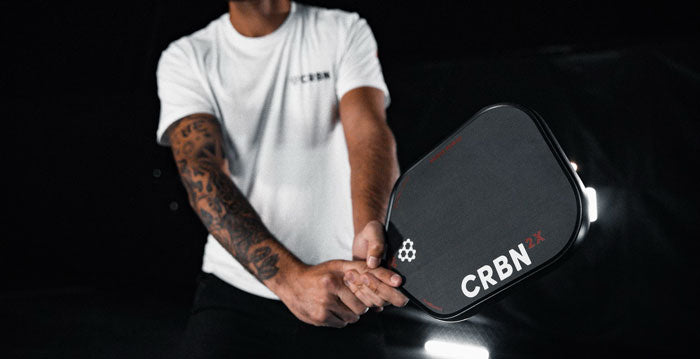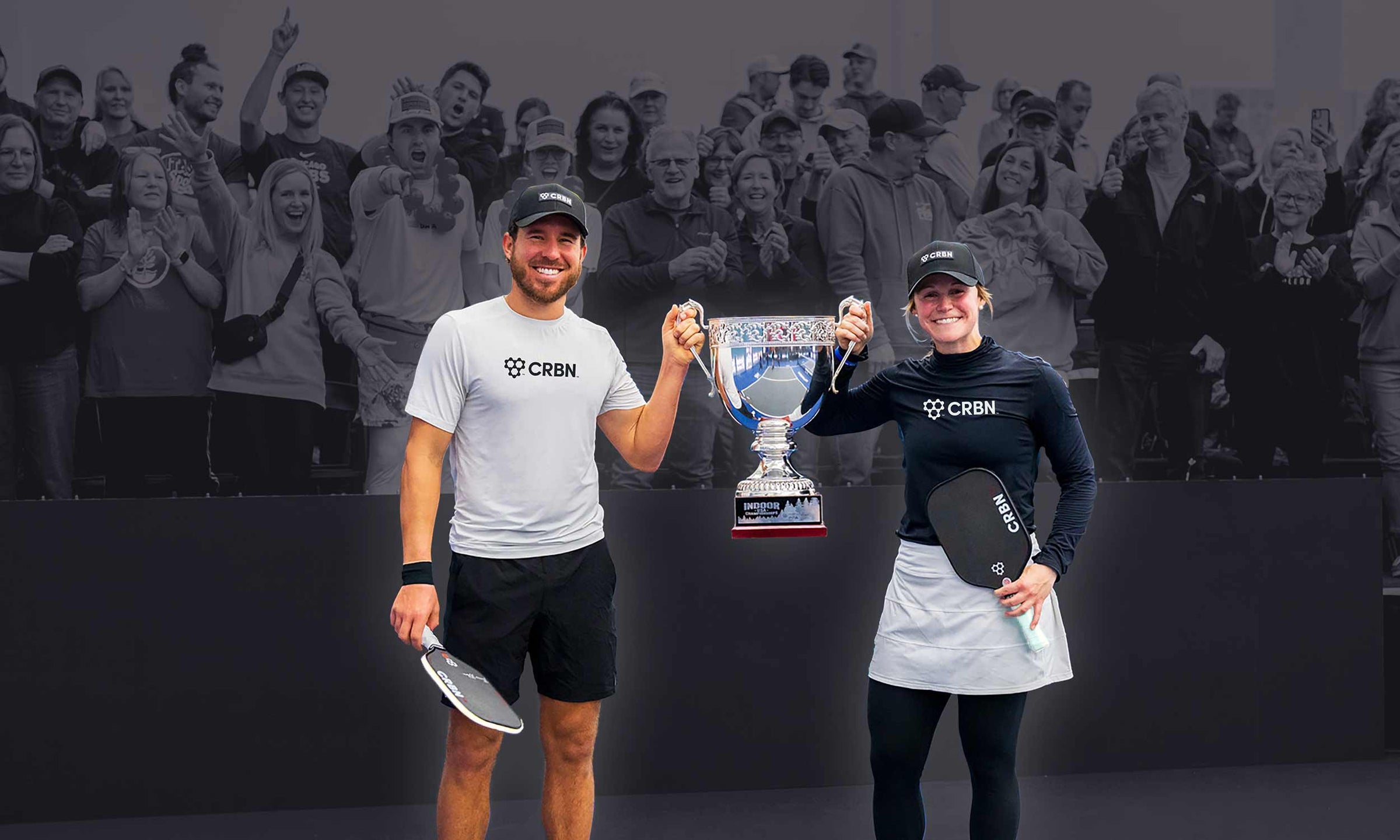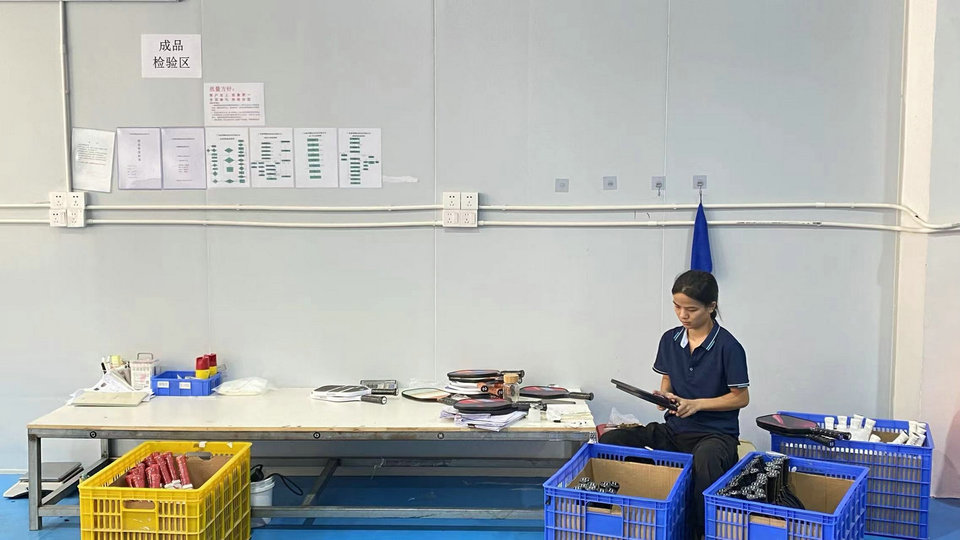Sie wissen nicht, wo CRBN-Paddel hergestellt werden? Diese Unklarheit hat Auswirkungen auf die Beschaffungsstrategie Ihrer Marke. Ich gebe Ihnen die direkte Antwort und erkläre Ihnen das "Warum" dahinter.
CRBN Pickleball-Schläger1 werden in Kalifornien entworfen, aber in Dongguan, Guangdong, China, hergestellt. Alle Modelle, einschließlich der Classic, X-Series und TruFoam Genesis, werden in Fabriken in Dongguan, Provinz Guangdong, hergestellt und tragen das Label "Made in China", wie von der Marke und den Händlern bestätigt.
Das Label "Made in China" ist nur der Anfang der Geschichte. Es eröffnet ein größeres Gespräch über globale Lieferketten2Qualitätskontrolle, und wie eine Marke wie CRBN so schnell zu einer dominierenden Kraft wurde. In meiner langjährigen Tätigkeit in der Branche habe ich dieses Modell schon oft erlebt. Lassen Sie uns tiefer in den rasanten Aufstieg des Unternehmens eintauchen und was das für Ihr eigenes Pickleball-Geschäft bedeutet.
Alle CRBN-Paddel werden in ihrem kalifornischen Hauptsitz hergestellt.Falsch
CRBN-Paddel werden in Kalifornien entworfen, aber die gesamte Produktion findet in Dongguan, China, statt. Der Standort in Kalifornien ist für Design, Marketing und die abschließende Qualitätskontrolle zuständig.
In den offiziellen Produktspezifikationen des CRBN wird China als Herstellungsland angegeben.Wahr
Einzelhändler wie Pickleball Central und die FAQs der Marke selbst bestätigen, dass alle aktuellen CRBN-Modelle in China hergestellt werden.
Eine kurze Einführung in die Marke CRBN (und ihren rasanten Aufstieg)?
Die plötzliche Marktdominanz von CRBN ist rätselhaft. Man fragt sich, wie ein neuer Marktteilnehmer so schnell wachsen konnte. Ich zeige Ihnen die Schlüsselfaktoren für das explosive Wachstum des Unternehmens.
Der rasche Aufstieg von CRBN ist auf die Konzentration auf Hochleistungsfähig3Rohkohlefaser-Paddel, die ernsthafte Spieler ansprechen. Sie kombinierten dies mit strategischem Profi-Sponsoring und einer starken Community-Präsenz und bauten schnell einen Ruf für Qualität und Leistung auf.

Aus meiner Sicht als Hersteller ist die Geschichte von CRBN eine Meisterklasse in Sachen Markteintritt. Sie haben nicht versucht, alles für jeden zu sein. Sie zielten auf eine spezifische, wachsende Nachfrage ab: Spieler, die mehr Spin von Rohkohlefaser4 Oberflächen.
Die "Grit"-Kontroverse
Ihr anfänglicher Erfolg war so groß, dass ihre Schläger von USA Pickleball wegen zu starker Oberflächenstruktur vorübergehend von der Liste genommen wurden. Dieser Rückschlag stärkte ironischerweise ihren Ruf. Er signalisierte, dass CRBN an die Leistungsgrenzen stieß. Sie gingen gut damit um, entwickelten ihre Schläger so um, dass sie den Anforderungen entsprachen, und gewannen das Vertrauen zurück.
Wichtige Wachstumsfaktoren
Hier ist eine einfache Aufschlüsselung ihrer Strategie:
| Strategie-Element | Auswirkungen auf das Wachstum |
|---|---|
| Produkt Nische | Konzentriert sich auf rohe T700-Kohlefaser. |
| Pro Endorsements | Verpflichtung von Spitzenspielern zur Bestätigung der Leistung. |
| Gemeinschaftliches Gebäude | Aktiv in sozialen Medien und Foren. |
Diese Kombination aus einem zielgerichteten Produkt, intelligentem Marketing und Widerstandsfähigkeit ist eine starke Blaupause für jede neue Marke, die in den Pickleball-Markt eintritt.
CRBN-Schläger wurden vorübergehend von der Liste der von USA Pickleball zugelassenen Schläger gestrichen.Wahr
Im Jahr 2022 wurden einige CRBN-Modelle von der Liste gestrichen, weil die Oberflächenrauheit die USAP-Grenzwerte überschritt. Das Unternehmen kümmerte sich schnell um das Problem und ließ die Paddel wieder zulassen.
CRBN war die erste Marke, die jemals Rohkohlefaser verwendet hat.Falsch
CRBN hat zwar die Rohkohlefaser-Oberfläche populär gemacht, war aber nicht das erste Unternehmen. Ihr Marketing und ihre Produktausführung setzten jedoch einen neuen Standard, dem viele Wettbewerber folgten.
Einblick in die Lieferkette: Warum fertigt CRBN in China?
Das Etikett "Made in China" ist oft mit negativen Stereotypen behaftet. Dieses Vorurteil kann Ihre Marke davon abhalten, die Vorteile leistungsstarker Produktionsstandorte zu nutzen. Ich zeige Ihnen die strategischen Gründe, warum Top-Marken dort produzieren.
CRBN produziert in China, um Zugang zu dem spezialisierten industriellen Ökosystem in der Provinz Guangdong zu erhalten. Diese Region ist eine Drehscheibe für Toray T700 Kohlefaserlieferanten und fortschrittliche Thermoformung5 Einrichtungen, die schnelle Innovationen, niedrigere Produktionskosten und eine skalierbare Fertigung ermöglichen.

Ich habe jahrelang Beziehungen zu Fabriken in Dongguan aufgebaut, der Stadt, in der die CRBN-Paddel hergestellt werden. Es geht nicht nur um billige Arbeitskräfte; das ist eine überholte Ansicht. Es geht um Know-how und Infrastruktur.
Die Macht der Industriecluster
Die Provinz Guangdong ist ein globales Zentrum für die Hightech-Produktion. Das bedeutet, dass alles, was eine Marke wie CRBN braucht, an einem Ort zu finden ist. Es gibt Rohstofflieferanten (wie für Toray T700 Carbon), Fabriken mit Tiefziehmaschinen und qualifizierte Arbeitskräfte. Diese Nähe beschleunigt alles, vom Prototyping bis zur Massenproduktion.
Wichtige Vorteile bei der Herstellung
| Vorteil | Beschreibung |
|---|---|
| Zugang zum Material | Direkte Beschaffung von hochwertigen Kohlenstofffasern. |
| Fortgeschrittene Technik | Zugang zu Thermoformung und Schaumstoffeinspritzung. |
| Skalierbarkeit | Fähigkeit, das Produktionsvolumen schnell zu erhöhen. |
| Schnelle Markteinführung | Schnellere Iteration vom Entwurf zum Endprodukt. |
Für eine Marke, die schnell innovativ sein will, wie bei ihrer TruFoam Genesis-Linie, ist dieses Ökosystem ein großer Wettbewerbsvorteil.
Die Provinz Guangdong ist ein wichtiges Zentrum für die Herstellung von Kohlenstofffasern und Verbundstoffen.Wahr
Die Region, insbesondere Städte wie Dongguan und Shenzhen, verfügt über eine hochentwickelte Lieferkette für Elektronik, Verbundwerkstoffe und Sportartikel, was sie zu einer strategischen Wahl für Marken wie CRBN macht.
Die Produktion in China wird nur wegen der billigen Arbeitskräfte gewählt.Falsch
Die Kosten spielen zwar eine Rolle, aber die wichtigsten Faktoren für Hightech-Güter sind der Zugang zu spezialisierter Technologie, qualifizierte Arbeitskräfte, etablierte Lieferketten und die Fähigkeit, die Produktion schnell zu steigern.
Paddel "Made in China" vs. "Made in USA": Kosten, Leistung, Garantie?
Die Wahl zwischen den USA und China als Produktionsstandort ist eine wichtige Entscheidung. Die falsche Wahl kann sich auf Ihre Kosten und Qualität auswirken. Ich werde die wichtigsten Unterschiede aufschlüsseln, um Ihnen die Entscheidung zu erleichtern.
Im Allgemeinen bietet die Herstellung in China niedrigere Stückkosten und Zugang zu Spitzentechnologie wie Thermoformung. In den USA hergestellte Paddel von Marken wie Paddletek und Engage haben oft höhere Kosten, profitieren aber von der Marke "Made in USA" und einer einfacheren inländischen Logistik.
Als jemand, der Marken dabei hilft, diese Entscheidung zu treffen, kann ich Ihnen sagen, dass es keine einzige "beste" Antwort gibt. Es hängt von Ihren Geschäftszielen ab. Eine Marke, die sich auf Spitzentechnologie und wettbewerbsfähige Preise konzentriert, könnte zu China tendieren. Eine Marke, die auf amerikanische Handwerkskunst setzt, würde sich für die USA entscheiden.
Kopf-an-Kopf-Vergleich
Leistung ist nicht an das Land gebunden; es geht um Design, Materialien und Qualitätskontrolle6. Ein gut gemachtes Paddel ist ein gut gemachtes Paddel, unabhängig von seiner Herkunft.
| Faktor | Hergestellt in China (z. B. CRBN) | Hergestellt in den USA (z. B. Engage) |
|---|---|---|
| Kosten pro Einheit | Im Allgemeinen niedriger | Im Allgemeinen höher |
| Technologie | Führend in der Thermoformung | Stark in der traditionellen Montage |
| Marke Appeal | Weltweit führend im Technologiebereich | Patriotismus "Made in USA" |
| Logistik | Längere Versandzeiten | Schnellerer Versand im Inland |
Marken wie CRBN beweisen, dass man mit der Produktion im Ausland Spitzenleistungen erzielen kann, wenn man den Prozess richtig steuert. Es geht um Kontrolle, nicht um den Standort.
Engage und Paddletek sind zwei große Marken, die ihre Paddel in den USA herstellen.Wahr
Nach Branchenprüfungen und eigenen Unternehmensangaben betreiben sowohl Engage (Florida) als auch Paddletek (Wisconsin) eigene Produktionsstätten in den Vereinigten Staaten.
Paddel "Made in USA" haben immer eine bessere Leistung als Paddel "Made in China".Falsch
Die Leistung wird durch Design, Materialien und Qualitätskontrolle bestimmt, nicht durch das Herkunftsland. Leistungsstarke Paddel werden sowohl in den USA als auch in China hergestellt, wobei unterschiedliche Technologien oft das entscheidende Unterscheidungsmerkmal sind.
Qualität und Konformität: Wie hält CRBN die USAP-Zertifizierung aufrecht?
Machen Sie sich Sorgen um die Qualität einer Fabrik im Ausland? Eine einzige schlechte Charge kann den Ruf Ihrer Marke zerstören. Ich erkläre Ihnen den mehrstufigen Qualitätskontrollprozess, den Top-Marken anwenden.
CRBN erhält die Qualität und die USAP-Zertifizierung durch ein strenges, mehrstufiges Verfahren aufrecht. Dazu gehören strenge Tests im chinesischen Werk, wie z. B. Durchbiegungs- und Kernbindungsprüfungen, gefolgt von einer abschließenden, intensiven Qualitätskontrolle in der Zentrale in Kalifornien.

Das Etikett "Made in China" bedeutet nicht, dass man auf Qualität verzichten muss. In meiner Tätigkeit helfe ich Marken bei der Einrichtung solider Qualitätskontrollsysteme (QC). Das Geheimnis ist, dass man sich nicht allein auf die Fabrik verlassen darf. Sie brauchen Ihre eigenen Kontrollen, ein Modell, das CRBN effektiv einsetzt.
Stufe 1: Prüfung auf Werksebene
Der Prozess beginnt in China. Bevor eine Lieferung das Land verlässt, werden die Chargen kritischen Tests unterzogen. Dabei werden u. a. die Durchbiegung (Steifigkeit) des Paddels, die Verbindung zwischen Kern und Schlagfläche und die Oberflächenrauheit geprüft, um sicherzustellen, dass das Paddel den USA Pickleball-Standards entspricht. Auf diese Weise werden größere Herstellungsfehler frühzeitig erkannt.
Stufe 2: Endgültige Qualitätskontrolle in den USA
Sobald die Paddel im CRBN-Hauptquartier in Kalifornien eintreffen, werden sie erneut inspiziert. Hier werden sie auf kosmetische Mängel geprüft, das Gewicht verifiziert und Seriennummern zur Nachverfolgung vergeben. Dieser zweistufige Prozess ist der Goldstandard, um Konsistenz und Konformität zu gewährleisten, und er ist entscheidend für den Schutz des Rufs einer Marke.
Das CRBN führt in seiner US-Zentrale eine abschließende Qualitätskontrolle durch.Wahr
Nach Angaben der Marke werden alle Paddel von China zu ihrem Werk in Kalifornien verschifft, wo sie einer abschließenden Qualitätskontrolle unterzogen und die Seriennummer nachverfolgt wird, bevor sie an Einzelhändler und Kunden ausgeliefert werden.
Die USA Pickleball-Zertifizierung ist ein einmaliger Vorgang, der nie wieder überprüft werden muss.Falsch
Die USAP kann jederzeit Paddel testen, insbesondere bei Turnieren. Marken müssen konsequent nach den Vorgaben produzieren, um ihren Zulassungsstatus zu behalten, wie die vorübergehende Streichung von CRBN von der Liste und die anschließende Wiederzulassung zeigen.
Schlussfolgerung
CRBN-Paddel werden in China hergestellt, um strategische Vorteile bei Technologie und Kosten zu erzielen. Mit strengen, mehrschichtigen Qualitätskontrollen liefern sie erstklassige Leistung und beweisen, dass die Herstellung in Übersee ein leistungsstarkes Modell ist.
Referenzen
-
Entdecken Sie die einzigartigen Eigenschaften und Vorteile der CRBN Pickleball-Schläger, die sie auf dem Markt auszeichnen. ↩
-
Untersuchung der Rolle globaler Lieferketten bei der Gewährleistung von Produktqualität und Effizienz. ↩
-
Entdecken Sie, was einen Pickleball-Schläger zu einem Hochleistungsschläger macht und wie er sich auf das Spielverhalten auswirkt. ↩
-
Erfahren Sie mehr über die Vorteile von Rohkohlefasern in Sportgeräten und ihre Auswirkungen auf die Leistung. ↩
-
Erfahren Sie mehr über die Thermoformtechnik und ihre Anwendungen bei der Herstellung hochwertiger Produkte. ↩
-
Informieren Sie sich über die besten Praktiken zur Aufrechterhaltung der Qualitätskontrolle in Fertigungsprozessen. ↩





